| 
Numbers of the Week
1 0 %
Premium income of Chinese insurers rose 10 percent year on year in the first quarter to reach 327.67 billion yuan ($48 billion), according to the China Insurance Regulatory Commission.
981 million yuan
Air China Ltd., a major domestic airline, reported a profit of 981 million yuan ($143.5 million) in the first quarter.
TO THE POINT: The Canton Fair, a barometer of the country’s export health, continued to send worrying signals as foreign buyers skimped on orders for Chinese products. The country’s fund managers cashed in on the stock market euphoria of the first quarter. The central state-owned enterprises bounced back from their previous dismal financial situation. China Mobile, the country’s largest mobile service provider, saw slower profit growth in the first quarter. The first domestic auto financing company with no foreign ownership opened in Shanghai.
By HU YUE
Faltering Fair
With sour business sentiment from the global economic downturn, the Canton Fair appears to be less of a gold mine for Chinese exporters this year.
The first phase of the fair on April 15-19 saw export deals worth $13 billion, a sharp decline of 20.8 percent from that of the previous fair in last October. The number of foreign buyers also dropped 5.4 percent to 82,520, according to fair organizers. As China’s top trade expo, the fair is widely considered a bellwether for the country’s export climate.
If the first phase of the fair failed to deliver a confidence boost, it was not for a lack of trying. Organizers lowered booth fees for sellers and for the first time opened its doors to domestic buyers.
Some foreign buyers have pared down their orders or demanded lower prices, while others stayed on the sidelines, expecting further price decreases for goods, said Mu Xinhai, a fair spokesman, in a statement. Flagging purchases from developed countries will bear down on China’s exports in the long term, he added.
While around 22,000 Chinese manufacturers competed for scarce foreign orders, some of them had taken advantage of green technologies to entice customers. The environmentally friendly and energy-efficient new products have been defying the downturn and attracted interest at the fair, said Zhang Yujin, Vice Chairman of the China Chamber of Commerce for Import and Export of Machinery and Electronic Products, in an interview with Economic Information Daily.
Funds Spring
No one doubted that China’s fund management companies had entered a bear market last year when they incurred painful losses. But now the bear appears to be hibernating, or at least taking a nap.
According to a report by Tianxiang Investment Consulting Co. Ltd. based in Beijing, 444 funds operated by the country’s 59 fund management companies raked in total profit of 296.2 billion yuan ($43 billion) in the first quarter, reversing a four-quarter, loss-making streak.
Of all types of funds, the best performers were stock-focused funds that contributed more than 70 percent to the total profit. The only losers were qualified domestic institutional investor (QDII) funds, which reported an overall loss of 139 million yuan ($20.3 million).
It is believed that the domestic stock market rally and loose financial market liquidity shored up the fund resurgence. The benchmark Shanghai Composite Index in the first quarter gained 28 percent in defiance of the economic downturns.
Yet, the funds’ combined net asset value only climbed a minimum 1.87 percent as the stock rebound triggered a spike in redemption requests from investors. The redemptions led to a net cash outflow from money market funds and bond funds from January to March.
Although a clear economic picture is yet to be seen, fund managers seem more convinced of the upside of the stock markets. The report by Tianxiang Investment showed that most of the fund managers built up their stock positions, betting on further market advances.
The stock market will continue to take some heat from government stimulus policies and liquidity although the upturn may grow quiet after a prolonged rally, the report quoted several fund managers as saying.
Central SOEs Regain Health
China’s industries are braced for a fast resurgence led by the 138 centrally administered state-owned enterprises (SOEs).
Their profits in March jumped a dizzying 26 percent compared with the same period last year, said Li Rongrong, Minister of the State-owned Assets Supervision and Administration Commission, on April 19 during the Boao Forum for Asia. Given their steep fall in profits in 2008, the March figure bodes well for a strong rebound for the rest of the year.
| 